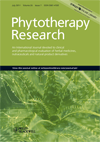Displacement of Bilirubin from Albumin in Plasma from Jaundiced Newborns. An In Vitro Study of Purified Chinese Herbal Constituents and Sulfisoxazole
Abstract
The aim of the present study was to clarify the in vitro potential of the purified Chinese herbal constituents LZX-A (neferine), QTJ (sinomenine), YHS (tetrahydropalmitine) and SQZG (notoginsenoside R1) to displace the highly bound bilirubin from albumin binding sites in plasma from jaundiced newborn infants. Sulfisoxazole (1.32 mm) was used as a positive control for bilirubin displacement. The displacing potential of the herbal constituents was investigated at assumed therapeutic concentrations and up to 100 times higher. Total (TB) and unbound (UB) bilirubin in plasma were measured by the peroxidase method. Sulfisoxazole increased the UB concentration in plasma by more than 60%. An increased % displacement of bilirubin was found at higher TB levels confirming the presence also of lower affinity binding sites for bilirubin in plasma. None of the purified herbal constituents showed any bilirubin displacing properties and were unaffected by the level of TB in plasma. The combination of sulfisoxazole and the herbal constituents showed no synergistic effect. It is concluded that none of the investigated purified herbal constituents possess any significant potential in vitro to increase the UB concentration in plasma from jaundiced newborn infants. Copyright © 2011 John Wiley & Sons, Ltd.




